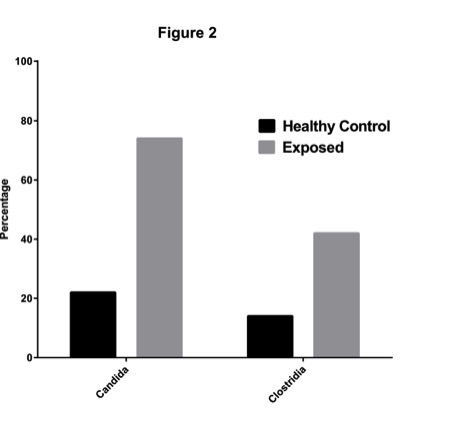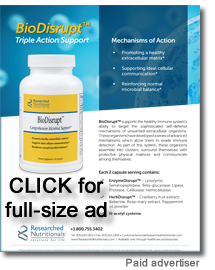Page 1, 2
The fourth benefit of using the OAT for patients with possible mycotoxin exposure is the yeast and bacteria markers. Exposure to mycotoxins can lead to the inhibition of T helper cell function and inhibition of antibody synthesis.36 Crucial immune organs have also been shown to decrease in size from exposure, such as the thymus, bursa of Fabricius, the spleen, and lymph nodes.37 This can lead to the overgrowth of intestinal pathogens such as Candida or Clostridia.38 Our data dictates that patients with high levels of mycotoxins have high levels of yeast 75% of the time and Clostridia 40% of the time (Figure 2). In this figure, we show that elevations in tartaric, arabinose, or carboxycitric acid are more common when the patient has been exposed to mycotoxins. These are serious co-morbidities that can lead to significant health issues. Diagnosis of these issues can lead to improved outcomes.
Figure 2

Treatment of Mycotoxins
Treatment of mold and mycotoxins must take into account possible routes of exposure; either internal colonization of mold or external exposure. Mycotoxin and fungi exposure can lead to many different symptoms including fatigue, headaches, difficulty breathing, rashes, gastrointestinal issues, joint pain, decreased libido, and more. As previously mentioned, these mycotoxins can come from water-damaged buildings or from food contamination. The most important element for treatment is avoidance of further exposure to water-damaged environments as well as contaminated foods. Using a licensed company to inspect and remediate the area is recommended. Remediation of contaminated areas is difficult because heat, ultraviolet (UV) light, bleach, ammonia, and ozone do not completely remove mold from contaminated areas.39 Air spore counts are frequently done; however they are usually done over a short period of time and often result in false negative results. Another problem is that killing the mold does not eliminate the risk, because mycotoxins will remain in the environment.
Patients exposed to mycotoxins from mold may have two different conditions to treat. The first is the mycotoxin exposure, which can cause problems in many different tissues mentioned previously, and second is a possible infection and colonization of the fungi. To detoxify the mycotoxins, it is recommended to use a combination of glutathione, sauna, sequestering/binding agents, and antioxidants. Patients may also need to treat fungi infections and colonization. Glutathione (GSH) can be introduced in several ways, including treating with GSH precursors such as N-acetyl cysteine and whey protein or with an oral liposomal, transdermal, intravenous, nebulized, or intranasal form of GSH. It is recommended to use GSH with sequestering agents, because treatment with GSH has been shown to increase the mobilization of mycotoxins in the bloodstream.40 Sauna therapy has been utilized for centuries for the removal of toxins from the body. Some of the most commonly used saunas are dry heat radiant saunas and far infrared saunas. Both have been shown to be equally good at removing toxins from the body. Infrared saunas have the advantage of inducing sweating at lower body temperatures. Sweating is important because many mycotoxins are lipophilic and can bind to lipid proteins, which will allow the mycotoxins to persist in the body for extend periods of time.41
Patients who have high levels of mycotoxins in their bodies may also be suffering from fungal infections and colonization. This is usually caused by direct exposure to elevated levels of mold spores. Fungal infections can occur in many different parts of the body. The most common areas of infection are the sinus cavities, lungs, and intestine. One Mayo Clinic study found fungal growth in 96% of patients with chronic sinusitis. The types of mold found included Aspergillus, Penicillium, Alternaria, Cladosporium, Fusarium, and Cryptococcus. All of these molds are known to produce mycotoxins and cause significant diseases.42,43 One study demonstrated that antifungal drug therapies were useful in combating microbial pathogens detected by gas chromatography-mass spectrometry.44
 Antifungal medications have been shown to be efficacious against mycotoxins. Multiple studies have utilized amphotericin B for the treatment of fungal infections.45-47 Other antifungals that have been used include ketoconazole, fluconazole, and itraconazole. For intestinal fungal infections, nystatin or liposomal nystatin may be a good alternative.48,49 Antifungal medications have been shown to be efficacious against mycotoxins. Multiple studies have utilized amphotericin B for the treatment of fungal infections.45-47 Other antifungals that have been used include ketoconazole, fluconazole, and itraconazole. For intestinal fungal infections, nystatin or liposomal nystatin may be a good alternative.48,49
Application of Antifungal Treatment in Autism and Parkinson's Disease
Our recent work with mycotoxins and antifungal treatment has focused on two different patient populations; those with autism and those with Parkinson's disease. Our studies have found numerous patients that exhibit symptoms of either autism or Parkinson's who also exhibit colonization with mold. Results indicate that treatment with antifungal therapies has greatly improved the symptoms of patients in these categories, which strongly suggests that mold exposure may play a role in exacerbating both autism and other neurological disorders.
Conclusions
Exposure to mold and mycotoxins can result in many different types of illnesses depending on the patient's age, sex, genetics, and environment. Determining the root causes of these illnesses is our goal at The Great Plains Laboratory. Many in the health community in the last decade have come to realize the role that mold and mycotoxins can play in the health of our patients. We believe that using the Organic Acid Test along with the LC/MS mycotoxin test can produce the information necessary to provide optimum personalized care to patients with mold exposure.
Page 1, 2
References .pdf
 Matthew Pratt-Hyatt, Associate Director of The Great Plains Laboratory, Inc., received his PhD in cellular and molecular biology from the University of Michigan. At The Great Plains Laboratory, he is focused on assisting with diagnosis and treatment of mitochondrial disorders, neurological diseases, chronic immune diseases, and more. He specializes in developing tools that examine factors at the interface between genetics and toxicology. His work is bringing new insight into how genes and toxicants interact and how that interaction may lead to mental health disorders, chronic health issues, and metabolism disorders. Matthew Pratt-Hyatt, Associate Director of The Great Plains Laboratory, Inc., received his PhD in cellular and molecular biology from the University of Michigan. At The Great Plains Laboratory, he is focused on assisting with diagnosis and treatment of mitochondrial disorders, neurological diseases, chronic immune diseases, and more. He specializes in developing tools that examine factors at the interface between genetics and toxicology. His work is bringing new insight into how genes and toxicants interact and how that interaction may lead to mental health disorders, chronic health issues, and metabolism disorders.
|
![]()
![]()
![]()
![]()








 Matthew Pratt-Hyatt, Associate Director of The Great Plains Laboratory, Inc., received his PhD in cellular and molecular biology from the University of Michigan. At The Great Plains Laboratory, he is focused on assisting with diagnosis and treatment of mitochondrial disorders, neurological diseases, chronic immune diseases, and more. He specializes in developing tools that examine factors at the interface between genetics and toxicology. His work is bringing new insight into how genes and toxicants interact and how that interaction may lead to mental health disorders, chronic health issues, and metabolism disorders.
Matthew Pratt-Hyatt, Associate Director of The Great Plains Laboratory, Inc., received his PhD in cellular and molecular biology from the University of Michigan. At The Great Plains Laboratory, he is focused on assisting with diagnosis and treatment of mitochondrial disorders, neurological diseases, chronic immune diseases, and more. He specializes in developing tools that examine factors at the interface between genetics and toxicology. His work is bringing new insight into how genes and toxicants interact and how that interaction may lead to mental health disorders, chronic health issues, and metabolism disorders.